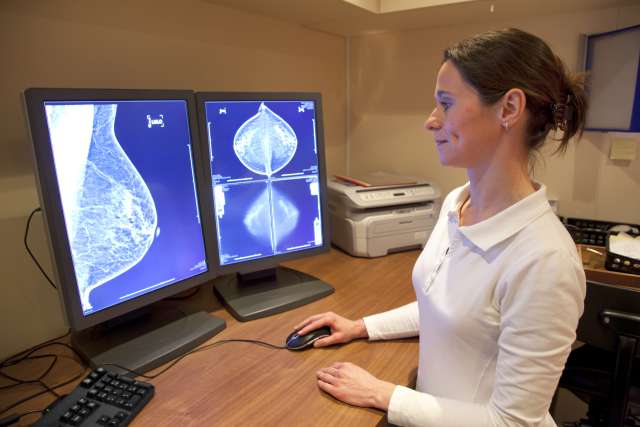In a new study led by the UCLA Health Jonsson Comprehensive Cancer Center, investigators show that using advanced MRI imaging and targeted focal therapy can help many men with low- to intermediate-risk prostate cancer safely stay on active surveillance long-term, helping avoid follow-up biopsies and delay — or even avoid — invasive treatments like surgery or radiation.
The team found that routine follow-up biopsy, previously considered essential, can now be replaced in most instances by MRI. Further, among men whose cancer was slightly more aggressive, those who had focal therapy were much more likely to avoid surgery or radiation than others who did not have the therapy. The researchers found 84% of men who received focal therapy avoided surgery or radiation, compared to just 46% of those who did not receive the treatment.
The findings, recently published online in the Journal of Urology, add to growing evidence that these tools can make active surveillance — where cancers are closely monitored rather than immediately treated — safer, more personalized and less stressful for patients.
“This represents a major advancement in the management of prostate cancer,” said Dr. Leonard Marks, professor and deKernion Endowed Chair in Urology at the David Geffen School of Medicine at UCLA, and senior author of the study. “By combining MRI-guided diagnosis with selective focal therapy, we can offer men a more personalized approach. This strategy not only helps avoid unnecessary procedures, but also gives us a better way to predict who will benefit from extended surveillance, potentially improving quality of life and reducing side effects without compromising safety.”
Prostate cancer is the most common non-skin cancer among American men, with about one in eight diagnosed during their lifetime. Many of these cancers are low risk and grow so slowly they may never cause symptoms. But despite growing acceptance of active surveillance many men still opt for surgery or radiation out of fear the cancer could become dangerous, which can cause significant long-term side effects such as incontinence or sexual dysfunction.
To help improve confidence in active surveillance and reduce the uncertainty that often leads to overtreatment, the UCLA team looked at whether incorporating two newer tools, MRI-guided biopsy and focal therapy, could make surveillance safer, more effective and easier for patients to stay on even longer.
MRI and MRI-guided biopsies give doctors a much clearer view of prostate cancer and make it easier to track changes over time with greater accuracy. When active surveillance was first introduced, these tools weren’t widely available, so physicians relied on traditional ultrasound-guided biopsies, which can sometimes miss important tumors or lead to overtreatment of slow-growing ones.
Focal therapy is a minimally invasive procedure that targets only the tumor instead of the whole prostate. The technique involves imaging guidance, such as MRI, to accurately locate the tumor and guide the treatment.
For the study, the team analyzed data from a cohort of 869 men prospectively enrolled in UCLA’s active surveillance program between 2010 and 2022. These data comprise the largest long-term study of men with prostate cancer monitored with MRI and MRI-guided biopsy at the start of treatment and as long as 12 years in active surveillance.
All participants had an MRI-guided biopsy at the start that showed low- to intermediate-risk prostate cancer, and they stayed in the program for at least one year. Starting in 2016, some men were offered focal therapy either because they had slightly higher-risk cancer at diagnosis or because their cancer showed signs of progressing. About a quarter (99 out of 393 eligible men) chose the treatment.
The researchers found that MRI was highly accurate in identifying stable cancers, correctly predicting non-progression in 90 to 95% of men with low-risk cancer and 70% of men with intermediate-risk cancer. By using MRI-guided biopsies from the beginning, doctors can more accurately assess the cancer and predict who can safely stay on surveillance.
And because the MRI is so accurate, the team found there was a reduced need for repeat biopsies. In many cases, men with favorable MRI results were able to avoid repeated biopsies altogether and reduce the chances of undergoing surgery or radiation.
The study also showed a decline in patients leaving active surveillance due to anxiety, which researchers believe may be tied to growing confidence in MRI-based monitoring and the safety of surveillance programs.
“Although the numbers for the focal therapy group are small and the follow up was relatively brief, the near-term advantage of focal therapy in avoiding surgery or radiation is clear,” Marks said. “This study offers some of the strongest evidence yet that active surveillance, when guided by modern imaging and minimally invasive treatments like focal therapy, can safely be expanded to more patients.”
While the results are encouraging, the researchers note that the study was conducted at a single medical center with specialized expertise, which may limit how well the findings apply to other settings.
The study’s first author is Shannon Martin, a senior medical student at the David Geffen School of Medicine at UCLA. Other authors, all from UCLA, are Samantha Gonzalez, Lorna Kwan, Merdie Delfin, Anissa Nguyen, Dr. Wayne Brisbane, Dr. Ely Felker, Dr. Anthony Sisk, Alan Priester and Shyam Natarajan.
The study was supported in part by grants from the National Cancer Institute and the Jean Perkins Foundation.




